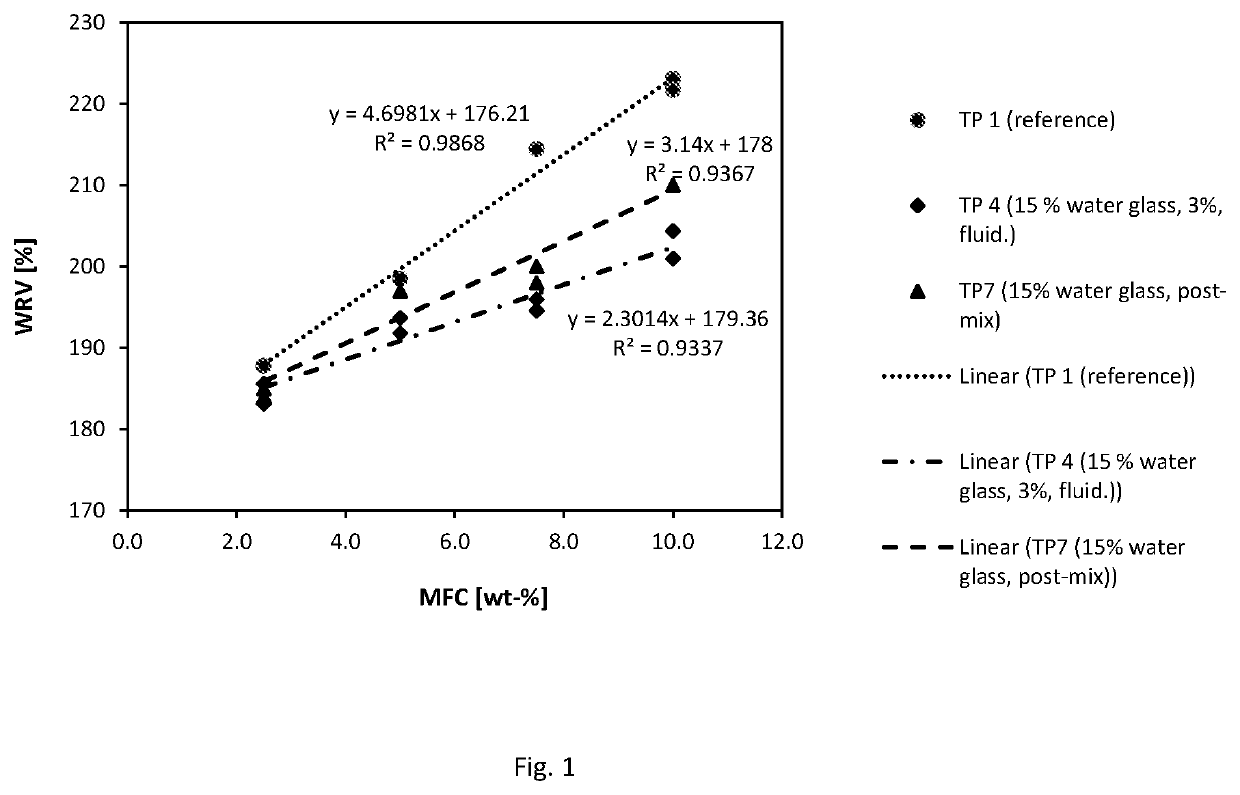Method for manufacturing a composition comprising microfibrillated cellulose
a manufacturing method and technology of cellulose, applied in the field of manufacturing a composition comprising microfibrillated cellulose, can solve the problems of low solid content, slow release of water, and high water binding capacity of mfc, and achieve the effect of efficient retention system and enhanced strength of thus produced paper
- Summary
- Abstract
- Description
- Claims
- Application Information
AI Technical Summary
Benefits of technology
Problems solved by technology
Method used
Image
Examples
example 1
[0034]A trial series was performed in which the dewatering resistance of MFC containing compositions produced according to the invention (sample 2-6) were compared with reference MFC compositions (sample 1 and sample 7). Reference sample 1 is MFC made from 100 wt % kraf fibers, without the addition of water glass. Reference Sample 7 is a mixture of MFC made from kraft fibers and water glass, wherein the MFC and the water glass have been mixed after refining (post-mixing). Reference samples 2-6 are compositions according to the invention wherein kraft fibers have been fibrillated in the presence of water glass.
[0035]The experiments were made using fiber suspensions of kraft fibers (pine) which were pretreated by wet disintegration at 3 wt % consistency at 30000 revs (British standard wet disintegrator).
[0036]The pH of the fiber suspensions were adjusted to approximately 9.5 before addition of sodium silicate. Water glass (sodium silicate) was added to the samples 2-6 prior to fibrill...
example 2
[0040]Another test series was performed to investigate the water retention value (WRV) of the compositions of the invention.
[0041]The reference MFC Sample 1, the Sample 4 of the invention and the reference post-mixing Sample 7 (all produced as in example 1 but with a fluidization concentration of 3%) were mixed with bleached never-dried birch kraft pulp (unrefined) in accordance with Table 3, wherein TP 1 refers to a mixture of Sample 1 with kraft pulp, TP 4 refers to a mixture of Sample 4 with kraft pulp and TP 7 refers to a mixture of Sample 7 with kraft pulp.
TABLE 3ApproximateTesttime of cakePointMFC,WRVforming,(TP)[wt %][%][min]12.51881515.01992717.521433110.02224842.5184645.0193847.519510410.02031072.5185675.01971077.519912710.021012
[0042]Pulp pads for centrifugation were formed using a vacuum filtration device equipped with a 0.65 μm DVPP filter. The cakes with approximately 7-15 wt % dry content were subjected to centrifugation and the water retention value was determined in ...
PUM
| Property | Measurement | Unit |
|---|---|---|
| temperature | aaaaa | aaaaa |
| temperature | aaaaa | aaaaa |
| temperature | aaaaa | aaaaa |
Abstract
Description
Claims
Application Information
 Login to View More
Login to View More - R&D
- Intellectual Property
- Life Sciences
- Materials
- Tech Scout
- Unparalleled Data Quality
- Higher Quality Content
- 60% Fewer Hallucinations
Browse by: Latest US Patents, China's latest patents, Technical Efficacy Thesaurus, Application Domain, Technology Topic, Popular Technical Reports.
© 2025 PatSnap. All rights reserved.Legal|Privacy policy|Modern Slavery Act Transparency Statement|Sitemap|About US| Contact US: help@patsnap.com

